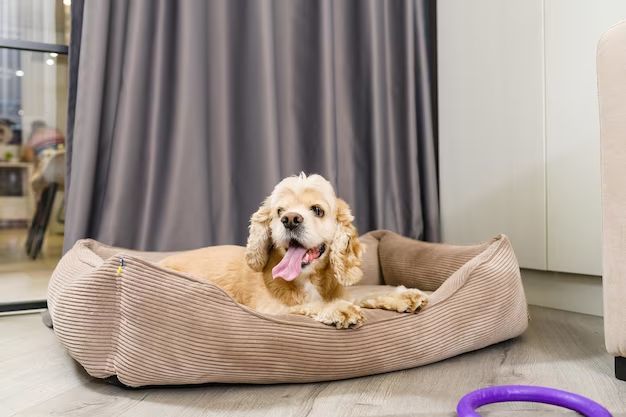Arthritis is a common condition in dogs, especially as they age. It causes pain, stiffness, and difficulty moving around. Providing an appropriate bed is one of the best ways to help an arthritic dog stay comfortable. The right bed can provide cushioning, support, and warmth to relieve pressure on joints. This allows the dog to rest more easily. When choosing a bed for an arthritic dog, there are several factors to consider. The ideal bed will be supportive yet soft, stable, and large enough for the dog to stretch out. Memory foam and orthopedic beds often provide the best combination of comfort and support.
Page Contents
What Causes Arthritis in Dogs?
Arthritis develops when the cartilage that cushions the joints breaks down over time. This causes inflammation, swelling, and stiffness. There are several types of canine arthritis:
– Osteoarthritis – This is the most common form, caused by normal wear and tear on the joints over many years. It usually starts around age 7.
– Rheumatoid arthritis – An autoimmune disorder that causes inflammation in the joints. It can occur at any age.
– Traumatic arthritis – Caused by an injury to the joints.
– Infectious arthritis – Joint inflammation caused by bacterial, viral, or fungal infections.
– Idiopathic arthritis – Arthritis with no known cause.
Certain breeds are prone to developing arthritis due to genetic factors. These include German Shepherds, Golden Retrievers, Labrador Retrievers, and Bulldogs. Obesity also puts added stress on the joints and can accelerate arthritis.
Signs of Arthritis in Dogs
Some common signs that a dog may have painful arthritis include:
– Difficulty getting up, lying down, or jumping
– Limping or favoring one side
– Lagging behind on walks or trouble with stairs
– Reluctance to run, play, or go for long walks
– Irritability or withdrawal due to discomfort
– Muscle loss in the affected limbs
If your dog is displaying these behaviors, a veterinary exam can determine if arthritis is the cause. X-rays or joint fluid analysis may be recommended to assess the joints.
Why Do Arthritic Dogs Need Special Beds?
Arthritic dogs need appropriate bedding for several reasons:
Cushioning
Beds with thick padding or memory foam provide soft, gentle support for aching joints. This protects bony areas that press against the floor.
Insulation
Arthritic dogs often feel cold due to inactivity and compromised circulation. Warm, insulated beds prevent heat loss.
Traction
Non-slip surfaces allow dogs to move on and off the bed more easily. This prevents falls and injuries.
Support
Orthopedic and memory foam beds conform to the dog’s body, keeping the spine aligned. This improves comfort and flexibility.
Nesting
Deep, snuggly beds let arthritic dogs burrow in and find the most comfortable position.
Containment
Raised edges keep the dog from rolling off onto hard floors if they have muscle weakness or stiffness.
Types of Arthritis Beds for Dogs
There are many types of dog beds designed especially for arthritic pets. Consider the dog’s size, sleep position, joint problems, and your budget.
Memory Foam Beds
Memory foam conforms to the dog’s body shape, relieving pressure points. It provides cushioning yet still supports the joints. Look for dense foam at least 4 inches thick. These beds tend to be more expensive but last longer.
Orthopedic Beds
Orthopedic beds have a firm base layer topped with thick foam or egg crate foam. They provide excellent support for painful joints.
Donut/Bolster Beds
For dogs that sleep curled up, a round bed with bolstered sides allows them to nestle in. The raised edges support the neck and back.
Heated Beds
Arthritic dogs are prone to chilliness. Electrically heated beds with chew-resistant cords keep the bed at a comfortable temperature.
Elevated/Cooling Beds
Lifted beds get dogs up off cold, hard floors. They promote air circulation to prevent overheating.
Durable Chew-Resistant Beds
For chewers or destructive dogs, look for tough ballistic nylon or ripstop fabric beds. Kevlar-reinforced edges prevent tearing.
Waterproof/Washable Beds
Accidents can happen with older, arthritic pets. Waterproof liners and removable, washable covers make cleanup easy.
Joint Support Beds
Some beds have built-in contoured bolsters and supports that hold the dog’s joints in proper alignment.
Crate Beds/Pads
Thick, chew-proof crate pads provide insulating, shock-absorbing comfort if the dog sleeps in a crate.
Choosing the Right Size Bed
It’s important to pick a bed large enough for the dog to stretch out and change positions, but small enough to feel secure. Measure your dog when lying down from nose to rump. Add 12 inches for small dogs, 18 inches for medium dogs, and 24 inches for large breeds. Square and rectangular beds give dogs more room to reposition their limbs.
Tips for Helping Dogs Adjust to a New Bed
– Place the bed in a quiet area away from high traffic.
– Put a favorite toy or worn T-shirt on the bed to make it smell familiar.
– Praise and reward your dog for lying on the new bed.
– Try a gradual transition – place the bed next to their old one at first.
– Be patient! It may take several weeks for an older dog to adapt.
– Use treats to gently lure the dog onto the new bed until they learn to use it.
Conclusion
Providing the right bed is key to managing arthritis pain and stiffness in dogs. Orthopedic and memory foam beds provide the best combination of soft yet firm support. Heated beds can also help dogs stay comfy. Be sure to choose a size appropriate for the dog to fully stretch out and get on and off the bed easily. With the right bed and a little patience during the transition period, arthritic dogs will gain much-needed restful sleep.
